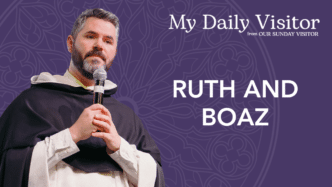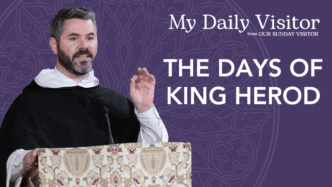Today is Dec. 15, the Third Sunday of Advent
We read in Sacred Scripture, “The LORD, your God, is in your midst, a mighty savior; he will rejoice over you with gladness, and renew you in his love, he will sing joyfully because of you, as one sings at festivals” (Zep 3:17-18a).
For centuries, the Church of the Nativity in Bethlehem has attracted pilgrims from near and far to kneel at the place where the Savior of the world was born. These journeys, often arduous and costly, demonstrate a profound desire to encounter Christ more deeply, to touch the very place on earth where heaven itself descended.
St. Cathal’s pilgrimage to Bethlehem may well have gotten lost in the annals of history were he not memorialized in the basilica itself. A column in the nave boasts his portrait. What made this seventh-century Irish monk’s journey to the Holy Land so remarkable? He was shipwrecked off the coast of Taranto, Italy, and the locals there made him their bishop!
St. Cathal’s pilgrimage to the Holy Land
But St. Cathal would have preferred to stay in the desert. Father J.F. Hogan describes his pilgrimage in the Irish Ecclesiastical Record: “With all the love and reverence of a pilgrim he sought out the holy places that had been sanctified by the presence of his Heavenly Master; and so great was his joy to live in these solitudes, and dwell on the mysteries of man’s salvation, amidst the very scenes in which it had been accomplished, that he earnestly desired and prayed to be relieved of his episcopal burden, and allowed to live and die in the desert in which our Lord had fasted, or in some one of the retreats that had been made sacred for ever by His earthly presence.”
When St. Cathal visited Bethlehem, he would have visited the church built at the initiation of the Emperor Justinian in the 500s. With the exception of the roof and floor, which have been reconstructed several times, the church is essentially unchanged down to the present day.
Let us pray,
O God, who see how your people faithfully await the feast of the Lord’s Nativity, enable us, we pray, to attain the joys of so great a salvation and to celebrate them always with solemn worship and glad rejoicing. Through our Lord Jesus Christ, your Son, who lives and reigns with you in the unity of the Holy Spirit, God, for ever and ever. Amen.






